Site menu:
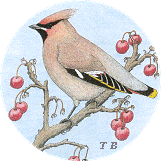
December 2008 Newsletter
Colour-ringed Black-tailed Godwits.
November Bird News.
Forthcoming Events.
Latest Newsletter.
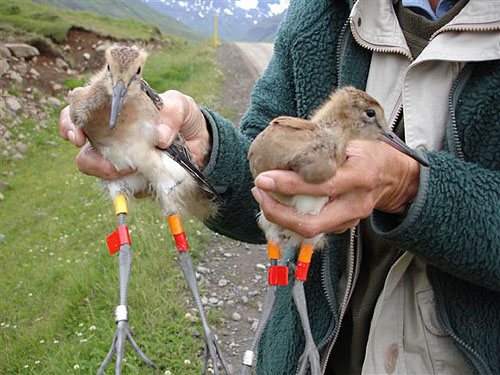
The fact that Black-tailed Godwits feature at the top of all this website's pages probably gives you a hint that they are one of my favourite birds. They are certainly a beautiful looking species, particularly in their breeding plumage, but even in winter they are striking in flight with their black and white wings and tail. But I particularly like to see them on their return migration in July and August when you get a whole mixture of plumages, a wonderful sight: non-breeding, juvenile and a gradation from full breeding to winter plumage.
The Black-tailed Godwits which visit the Dee Estuary are
of the Icelandic sub-species - Limosa limosa islandica. As suggested
by their name nearly all of these birds breed in Iceland. The Dee Estuary
is a very important site for this Icelandic population, over the past few years we have
had either the highest or second highest numbers in the country for both
migrating and wintering birds. In 2007 max numbers reached 5,278 in
November, with migrating birds reaching 1,549 in July and 2,490 in August.
These are important numbers in an international context with the total
number for this sub-species estimated at 47,000. Many of these birds which
are on the Dee Estuary in late summer are on their way to spend winter in
southern UK, France, Portugal and Spain. We know this because many of these
birds are individually colour ringed, between 1 and 2% of the population
are ringed in a scheme which has been ongoing since 1999. Operation Godwit,
as the project is called, has been very successful - there is a very high
resighting rate, for example over 90% of adults ringed in Iceland have been
recorded in other countries; this has produced a wealth of information on
migration routes, feeding patterns and population dynamics. To see more
details see the Operation Godwit website -
http://www.uea.ac.uk/~b072834/index.html (this URL may change soon as
they are in the middle of producing an updated website).
In this article I am going to concentrate on the colour ringed birds recorded on the Dee Estuary, for which I have managed to collate details of 58. Admittedly this is a very small sample, nevertheless some interesting data has come from these birds. First, a bar chart:
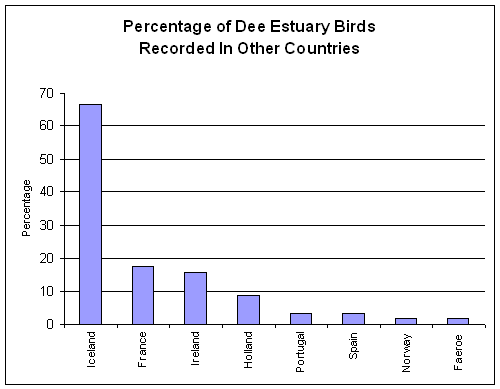
The bar chart shows the different countries visited by the birds recorded on the Dee Estuary, note that Ireland includes northern Ireland as well as Eire. You may wonder as these are Icelandic breeders why that figure is not 100%, but Iceland is a big country, of course, and not all returning colour ringed birds are seen again. Many birds which pass through the Dee Estuary in late summer are on their way south with some finding their way to France and, to a lesser extent, Portugal and Spain. Quite a lot winter in Ireland, no doubt there is a lot of interchange between there and north-west England. All the birds recorded in Holland were seen in spring, presumably on their way back to Iceland via an easterly route. The Norway and Faeroe records were of one single bird which appears to have been a wandering non-breeder. Of the 58 birds for which I have data 35 overwintered here, one was a spring migrant, three were non-breeding birds which spent the summer here and the remaining 18 passed through here in late summer and autumn.
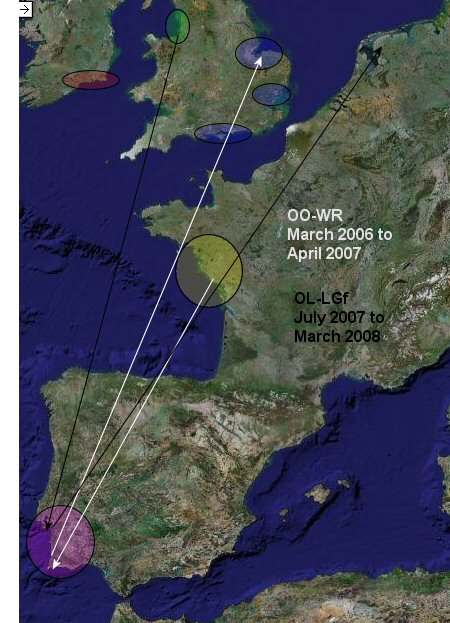
The map, right, shows some of the main wintering areas of Islandica 'Blackwits'. The green area is north-west England/ north-east Wales, including the Dee Estuary. Blue is the Wash, East Anglia, the Thames Estuary and the south coast of England. Red is south-east Ireland. Yellow is southern Brittany and the northern part of the French Atlantic coast. Purple is Portugal, mainly the Tagus Estuary and nearby rice fields and salt pans. Below is a summary of the records for five birds which give an idea of the movements of the Icelandic Black-tailed Godwits.
OL-LGflag (L is code for Light green) was ringed in Portugal in November 2006 and was subsequently recorded spending the winter on the Tagus estuary for the rest of that winter and the following winter (2007/08), it has already been seen back there this autumn, on Oct 11th 2008 - this is a good example of how site faithful these birds are. This bird was recorded at Inner Marsh Farm RSPB reserve late July in 2007. Ringing indicates that many birds pass through here and the nearby Dee Estuary in July and August before making their way further south, this movement may well involve several thousand birds.
The area of Portugal where this bird winters is also used in winter by many Black-tailed Godwits of the continental race, (L l limosa), it is also a staging post in the spring for the limosa birds which are returning in their thousands from Africa. Many of these breed in Holland and it is interesting that in both the spring of 2007 and 2008 that OL-LGflag has passed through Holland on it's way back to Iceland. It seems very likely, therefore, that some of the Islandica birds join in with the continental birds to fly north-east, before subsequently flying north-west to Iceland.
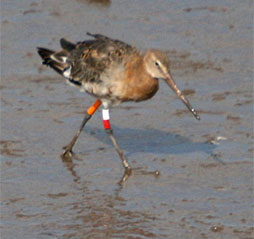
Like the above bird OO-WR, pictured left at the Connah's Quay Reserve on Aug 23rd 2008 (photo by Andrew Wallbank), spent the winter of 2006/07 in Portugal - but there the similarity ends. The previous winter (2005/06) the bird was first seen on the Wexford Slobs in southern Ireland, and then on the west coast of France. It visited the Ouse Washes in the spring of 2007, a very popular spring stop off point which often has over 3,000 birds present in March. The second half of 2007 saw it at Inner Marsh Farm in late July and then the Connah's Quay Reserve in October. It then spent most of the winter on the Dee Estuary, with a visit to Marshside RSPB reserve, Southport, in late January. This visit to Marshside was not a lone journey - a remarkable 4,000 were there at the same time and included many from the Dee Estuary. They didn't seem to stay very long as many returned to the Dee a few days later. We don't know what drives these movements but presumably it must be something to do with the availability of food. Marshside RSPB is a freshwater site, there was a period of heavy rain in the third week of January which must have made this reserve particularly attractive to them. This autumn and winter (2008) this bird has returned to the Dee Estuary area being seen at Connah's Quay and West Kirby, and three times in November at Thurstaston, including the 30th, just a day before this newsletter was published!
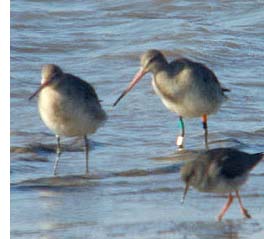
The photo on the right is of ON-G//W (N=black, // means the ring is below the knee) photographed on Thurstaston shore by myself in February 2008. It was ringed as an adult female near the Wash on Aug 22nd 2005, it was still at the Wash on Nov 5th then had it's first visit to the Dee at Thurstaston on Dec 28th. It has since been see here January 2006, then later in the same year in November and December. In January 2007 it paid a visit to the Nene Washes. This was another bird which visited Marshside RSPB in late January 2008 being seen both previously and subsequently at Thurstaston during that winter. After returning to the Dee Estuary in February 2008 it was last seen here on March 5th, four days later it was on the Nene Washes again before returning yet again to the Dee Estuary on March 18th, at Inner Marsh Farm. These east/west movements are fairly typical with many birds moving east through the winter prior to their spring migration back to Iceland.
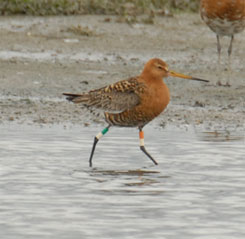
OW-GW is an east coast bird only recorded once on this side of the country when this photograph was taken on Jul 8th 2008 at Inner Marsh Farm RSPB by Phil Woollen. It is an adult male in full breeding plumage, presumably just back from Iceland when the photograph was taken, although it has never actually been seen there. It was initially ringed as a juvenile near the Wash in August 2003, and subsequently spent the following summer as a non-breeder in Norfolk. There has only been one winter record of this bird - it was near Boston, Lincs, in Nov 2004. All other sightings have been during either spring or autumn. Most are from sites around the Wash, East Anglia and north Norfolk, but it paid a visit to Leigh-on-Sea in the autumn of 2006, where it also went just after this photograph was taken in 2008. In April 2006 it was recorded in Holland, again showing a typical eastwards movement - although we have no idea where it actually spends the winter!
The ringed bird below was photographed at Heswall by Charles Farnell in December 2005. It is OG-GL, the light green ring looks white in the bright sunshine but the reflection shows the true colour. This is a male which was ringed in Iceland in April 2000 and subsequently recorded there in 2004, 2006, 2007 and 2008. Like many other birds it shows an eastwards movement into spring. Each of the winters 2005/06 to the current one it has spent on the Dee Estuary, frequently being seen at Thurstaston and Heswall. Usually by February or March it is recorded on the east coast either in north Norfolk or the Ouse Washes, before returning to Iceland in April. It was last recorded on Nov 29th 2008 on Heswall Shore, two days before this newsletter was published.
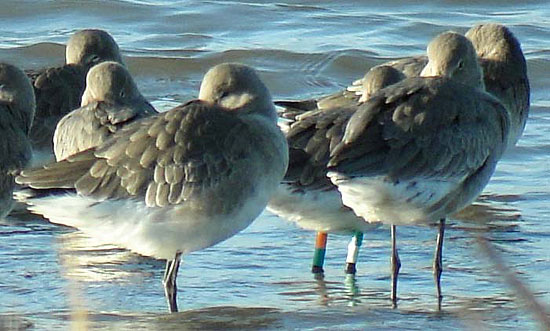
Acknowledgements
1. Operation Godwit, all those 'Blackwit' enthusiasts who do the ringing and subsequent data compilation, and who are so prompt at sending out details to people who send their records in, key people are: Tomas Gunnarsson and Sigga Beta (who maintains the database) in Iceland, Jenny Gill, Graham Appleton, Pete Potts and Ruth Croger in UK, Becca and Jim Wilson in Ireland, Guillaume Gelinaud and Julien Gonin in France and Jose Alves in Portugal. Also the Farlington Ringing Group and University of East Anglia play an important part.
2. I have obtained ringing information from various sources, I would like to thank in particular the following individuals among the many who have sent me data: Charles Farnell, John Jakeman and Andrew Wallbank who have all sent numerous records to me. I have also obtained ringing information from the Merseyside Ringing Group and the local RSPB for which many thanks.
References:
1. WeBS Report 2006/07 and Dee Estuary WeBS Report 2006/07.
2. Cheshire and Wirral Bird Report 2007.
3. Species spotlight - Black-tailed Godwit, December 2006 Dee Estuary
Newsletter,
http://www.deeestuary.co.uk/news1206.htm .
4. Waterbird Population Estimates, Wetlands International, 2006.
Please send any Black-tailed Godwit ringing records to Operation Godwit (http://www.uea.ac.uk/~b072834/index.html - but this URL may change soon as they are in the middle of producing an updated website) or to myself by . I will forward the info back as soon as I get it. In any case - if you could pass any records you have of colour ringed Black-tailed Godwits seen on the Dee Estuary or nearby fields/wetlands to me I would be very grateful; they will form the basis for future articles!
Richard Smith
November Bird News
The first Rough-legged Buzzard I've ever seen turned up on Middle Eye (Hilbre) on Nov 5th. This was observed by just one birder but luckily it turned up again over Hilbre the following day when it was also seen at Cubbin's Green, West Kirby, then later in the day over the sand dunes on West Kirby Shore - which is where I saw it. It was still there the following morning for a couple of hours before disappearing. I was surprised how different it looked to a Common Buzzard, not only was it noticeably paler but it was also quite a lot bigger - an impressive bird. Rough-legged Buzzards are rare in our area, the last record which was accepted for the Dee Estuary was one on Parkgate Marsh in 1987.
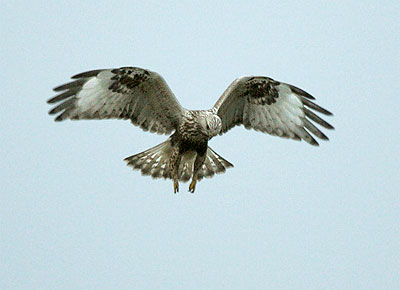
Not as rare, but still nice to see, was a Great Northern Diver. It first turned up on the sea just to the north of Hilbre on the fifth, presumably the same bird then made its way to West Kirby Marine Lake on the 10th where it stayed for the rest of the month - probably the month's most photographed bird in the whole country!
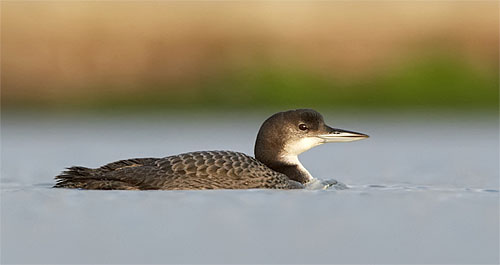
More unexpected, after a few days of north-west gales, were 2 Leach's Petrels and a single Storm Petrel on the 21st. This is one of the latest Storm Petrels ever recorded for Hilbre. On the same day eight Eiders were observed, with a single female reported on many days through the month. Also on Hilbre we saw a rapid build up of pale-bellied Brent Geese with a max of 119 on the 20th with a single dark-bellied, easily the highest ever recorded November count (96 last year).
The other big bird news story is the amazing numbers of Short-eared Owls on the marshes. 25 were counted on the 16th with at least 24, possibly as many as 30, on 22nd - both counts from Burton Marsh. There have also been up to eight off Parkgate, when you take into count that many others must be hiding in the marsh waiting for dark as far down as Heswall and across on the Welsh side, there must be getting on for 50 in total for the whole estuary! I have heard various reasons for the high numbers - firstly it must obviously be a good vole year here, secondly there has been, apparently, a very good breeding season in Scotland, and thirdly there is a reported lack of food in Scandinavia where many of the owls migrate from. Hen Harriers are also doing well this winter with a reliable count of five birds coming in to roost at Parkgate on the 28th, this included a full 'grey' adult male and a mainly grey sub-adult male, plus three ringtail birds. There were two reports of single Marsh Harriers in the first half of the month.
It looks like being a good winter for Waxwings across the country, although, not unexpectedly, we have only seen a few here so far. Two records were of fly overs - two on the 7th and 30 on 12th, both on West Kirby Shore - the latter flew across to North Wales where there were subsequent reports of small flocks from various sites, but not close enough to count as the Dee Estuary! The other record was of two on 15th and three on 22nd feeding on Rowan berries in a Caldy garden.
Five Snow buntings were on West Kirby Shore on 12th and the same number on Little Eye on 22nd, with one to three reported on several days in the same area on several other dates. There may well have been seven present on the 22nd as two were on Leasowe Shore on the same day five were on Little Eye. There were several reports of single Firecrests, with three observed in Greasby on the last day of the month.
What to expect in December
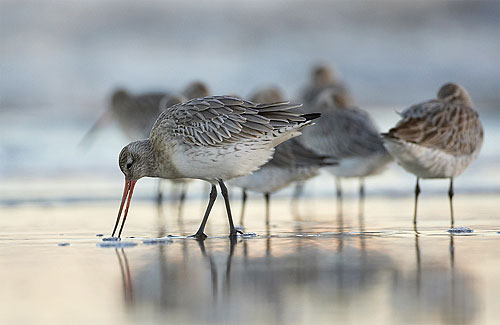
was one of several sent to me by Richard Steel.
Hopefully we will get a flock of Waxwings in our area which will stay for a few days, there are certainly plenty in the country at the moment. They can turn up just about anywhere and seem to prefer Rowan trees in supermarket car parks!
So far it has been a very good winter for both Hen Harriers and Short-eared Owls. Hen Harriers can be seen patrolling the marshes at any time but they are most reliably seen when going into their roost off the Old Baths car park at Parkgate, get there at least half an hour before dusk. Short-eared Owls are most numerous on Burton Marsh - they are best seen on a day without any wind.
Will the Brent Geese carry on increasing? I suspect numbers will stay around the 120 mark this month before increasing again in the New Year. They are best seen at low tide on the rocks around Hilbre, or at high tide on the sea around Little Eye.
We often get some nice sunny still days towards the end of December and this really seems to bring in good numbers of waders. Thurstaston Shore is a great place to see large numbers of waders at low tide busy feeding right up to the beach, otherwise try Point of Ayr, West Kirby or Hoylake at high tide. A Greenshank appears to be overwintering at Heswall, best seen on the mud opposite the end of Target Road before or after high tide, whilst the gutter is full of water. A few Spotted Redshanks usually turn up through the winter with Inner Marsh Farm or the Connah's Quay Reserve the best sites to see these.
Forthcoming Events
See also Bird Events 2009 (January to March)
December Highest Spring Tides (Liverpool)
Also see
Tides page.
14th December, 12.05hrs (GMT), 9.7m.
15th December, 12.54hrs (GMT), 9.7m.
Forthcoming Events
Organised by the
Wirral Ranger Service ,
Flintshire Countryside Service and/or the RSPB:
All these events and walks have bird interest, even those not advertised
specifically for birdwatching. No need to book for these events unless
specified - please check below.
Sunday 14th December 9.30am start,
Marsh Matters. High tide at 1205hrs, 9.7m.
Join the Rangers at Riverbank Rd car park to watch over the Dee Marshes as
the tide sweeps in.
Watch for waders, ducks, raptors and maybe an elusive Water Rail or two!
No need to book, meet at Riverbank Rd car park, Lower Heswall.
For more info: (0151) 648 4371/3884.
Sunday 21st December 2.30pm
Parkgate Raptor Watch
Come along and watch birds of prey with the experts. See the graceful hen
harriers coming in to roost on the RSPB reserve. Other birds of prey we
hope to see are merlin, peregrine, sparrowhawk, short-eared owl and barn
owl. Meet at the Old Baths car park, which overlooks the Dee Estuary RSPB
Reserve at Parkgate, close to The Boat House pub. No need to book.
Saturday 10th January 9:30am start (HW 10am, 9.2m).
‘Birdwatch at King’s Gap, Hoylake’
Come along to Hoylake Foreshore and join members of the Coastal Rangers,
the Dee Estuary Voluntary Wardens and the RSPB and see what birds can be
seen feeding on the outgoing tide. This event is suitable for all the
family to enjoy. All children under 8 must be accompanied by an adult.
Dress warmly and bring binoculars if you have them. Meet at King’s Gap on
Hoylake Promenade. For further enquiries Tel: 0151 678 5488.
Tuesday 13th
January 11:15am
Parkgate Birdwatch
High tide at Parkgate is the best time to discover the hidden treasures of
the Dee Estuary RSPB reserve. As the sea covers the marsh many hundreds of
waders and wildfowl will be brought closer to the shore, there should be
good views of Short-eared Owls and various raptors, including Hen Harriers
and Peregrines. If the tide reaches the wall, small mammals
such as voles, shrews and possibly water rails are flushed out. Meet at
the Old Baths car park overlooking the reserve at Parkgate, close to The
Boat House pub (HW 12:40, 10.0m). No need to book.
Sunday 18th
January 3pm
Parkgate Raptor Watch
Come along and watch birds of prey with the experts. See the graceful hen
harriers coming in to roost on the RSPB reserve. Other birds of prey we
hope to see are merlin, peregrine, sparrowhawk, short-eared owl and
barn owl. Meet at the Old Baths car park, which overlooks the Dee Estuary
RSPB Reserve at Parkgate, close to The Boat House pub. No need to book.
|
 |
The blank (UK) Birding Webring is a collection of quality birding web sites that are based in the United Kingdom. Visit the webring homepage for more information, or A complete list of all the sites in the webring is available by clicking here. previous site in ring : random site in ring : next site in ring |